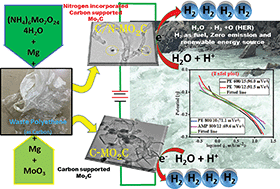An ecofriendly route to synthesize C-Mo2C and C/N-Mo2C utilizing waste polyethene for efficient hydrogen evolution reaction (HER) activity and high performance capacitors†
Abstract
In the present work, molybdenum carbide (Mo2C) supported by in situ developed surface carbon (C-Mo2C) and molybdenum carbide (Mo2C) supported by nitrogen incorporated carbon (C/N-Mo2C) have been synthesized in an autoclave. Synthesis of both C-Mo2C and C/N-Mo2C is done in an environment friendly way using waste polythene as a source of carbon. Nitrogen incorporation into the supported carbon matrix over Mo2C enhances the hydrogen evolution reaction (HER) activity and durability. C/N-Mo2C shows a lower Tafel slope of 69.2 mV dec−1 and an overpotential of 197.37 mV to achieve a current density of 10 mA cm−2. It also shows negligible loss of current even after 2000 cyclic voltammetry (CV) cycles and retains the same current density value for 10 hours as determined by chronoamperometry (CA). The electric double layer capacitance (EDLC, Cdl) measurements reveal a higher capacitance value of 21.3 mF cm−2, for C-Mo2C. C-Mo2C (PE 800/10) exhibits a higher power density of 17.9 W kg−1 due to its smaller resistance between the electrode and electrolyte. The proposed environment friendly strategy can pave the path to use waste polyethene not only for the HER and capacitors, but also for other materials applicable in lithium ion batteries and fuel cells. This also provides a way to address the environmental problems caused due to these wastes.



 Please wait while we load your content...
Please wait while we load your content...